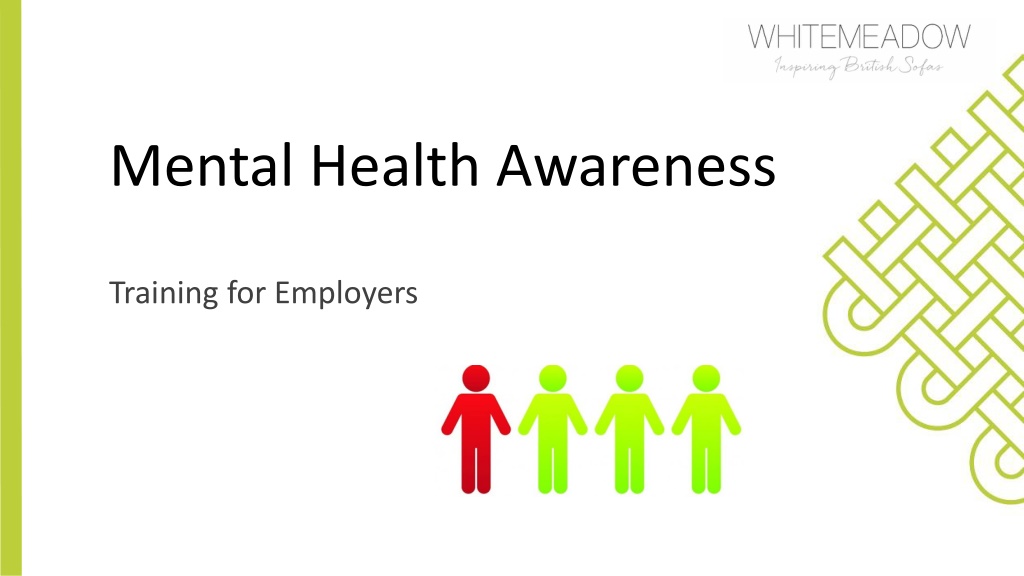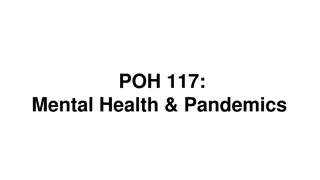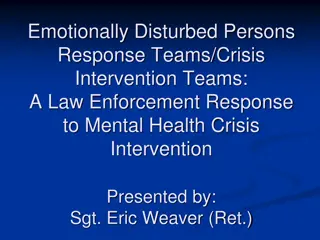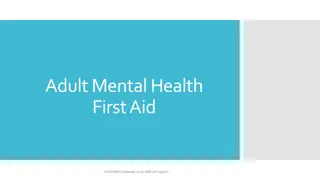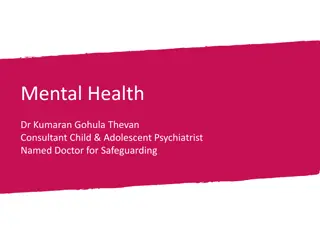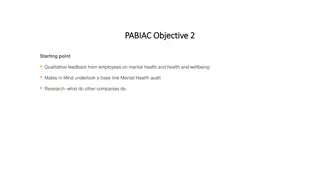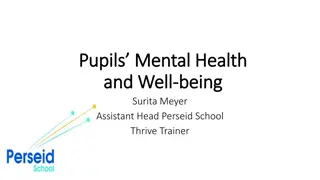Mental Health Awareness Training for Employers
This mental health awareness training for employers covers the importance of good mental wellbeing, common signs of poor mental health, early intervention strategies, statistics on mental ill-health impact in the workplace, and more. It emphasizes the need for open conversations about mental health to create a supportive work culture.
Download Presentation

Please find below an Image/Link to download the presentation.
The content on the website is provided AS IS for your information and personal use only. It may not be sold, licensed, or shared on other websites without obtaining consent from the author.If you encounter any issues during the download, it is possible that the publisher has removed the file from their server.
You are allowed to download the files provided on this website for personal or commercial use, subject to the condition that they are used lawfully. All files are the property of their respective owners.
The content on the website is provided AS IS for your information and personal use only. It may not be sold, licensed, or shared on other websites without obtaining consent from the author.
E N D
Presentation Transcript
Mental Health Awareness Training for Employers
Aims and Objectives The importance of good mental wellbeing Commonly held perceptions about mental health Common signs and symptoms of poor mental health Strategies for early intervention and support 2
Why is mental health important? Exercise: what impact do mental health issues have on our business? 3
Good mental health is important because There is no Health without Mental Health (Dept of Health 2011) 4
Mental Ill Health: The Statistics A recent CIPD survey found that: 37% of sufferers are more likely to get into conflict with colleagues 57% find it harder to juggle multiple tasks 80% find it difficult to concentrate 62% take longer to do tasks 50% are potentially less patient with customers / clients. Further studies have also found that 1 in 4 people have mental health issues and costs UK employers an estimated 30 billion each year in absence, recruitment and lost productivity. 5
How do we view mental health? Exercise: what do you think of when you hear the word mental? 6
Culture of Science We don t know much about it So we are a little scared of it So we don t recognise it So we don t talk much about it So we don t learn much about it 7
So we dont talk much about it Employees are reluctant to raise the subject Managers shy away 8
Which are mental health conditions and which are not? Dyslexia M.E. / Chronic fatigue Depression Asperger syndrome Stress Bipolar disorder Autism Epilepsy Anxiety Psychosis Schizophrenia Learning difficulties 9
What is mental ill health? Mental health is a state of well-being. Mental ill health has a varied definition. It has a wide spectrum, from the worries and grief we all experience as part of every day life to the most bleak, suicidal depression or complete loss of touch with everyday reality. 10
The Mental Health Continuum Maximum mental wellbeing A person with a diagnosis of a serious illness but who copes well and positive mental wellbeing A person with no illness or disorder and positive mental wellbeing Maximum mental illness / disorder Minimal mental illness / disorder A person with a diagnosis of a serious mental health condition and who has poor mental wellbeing A person with no diagnosis but has poor mental wellbeing Minimal mental wellbeing 11
Common mental health conditions Stress and pressure Anxiety Depression Bi-polar disorder Psychosis and schizophrenia Eating disorders Drug and alcohol addiction Obsessive compulsive disorders Self harm More severe conditions 12
What damages mental health? Misuse of drugs and alcohol Other extreme behaviours Avoidance and isolation Lack of activity or over activity Lack of valued job or role Repeated dismissive or disrespectful treatment Discrimination Bullying and harassment Poverty and social deprivation Exclusion or abuse Prolonged uncertainty or anxiety 13
How can we recover? Medication Psychological therapies Specialist services Good help and support at work 14
Spot the signs Changes in behaviour Irritability Tiredness Lateness Physical symptoms e.g. headaches Emotional symptoms Saying things like I can t cope Other staff concerns Other staff avoiding this person 15
What can we influence? Factors you cannot Factors you can control outside work: influence in work: Overlapping factors you can try to influence: Money Status Friendships Sense of purpose Stress Coping strategies Lifestyle choices Childhood experiences Workload Family relationships Work variety Addiction problems Work relationships Finances Involvement Genetics Culture of disclosure Crime Communication Housing Bullying Bereavement 16
How do we engage with staff? Exercise: how would you approach the case study scenarios? 17
How to engage with staff How to respond? Who starts the conversation? What to say? Recognising when professional help is needed? Dealing with emotions 18
The conversation DO: DO NOT: Have a conversation in a private place Attempt to start a conversation in front of everyone else Make sure there are no interruptions Initiate a conversation if you ve got another appointment looming Be focused on supporting your employee Ask open questions, e.g. I was wondering how you are doing. Attempt to diagnose (you are not a doctor) Allow the person time to answer Push for answers, be patient Try to see yourself in their shoes and see things from their perspective Tell the person what to do Leave things up in the air Make arrangements for a follow up meeting to review the situation 19
Supporting mental health What currently happens in the workplace to support staff who may have a mental health condition? And what could you do even better? 20
Policies and procedures Get buy in from the top Have a policy Train managers Make employees aware Create a culture of respect 21
Legalities and liabilities Equality Act 2010: Discrimination occurs when someone is treated less favourably than another person because of a protected characteristic. Disability is one of these protected characteristics which is defined as: A physical or mental impairment that has substantial and long term negative effect on your ability to do normal daily activities. 22
Right to reasonable adjustments Schedule modification Job modification Environment modification Policy changes Providing human assistance Providing technological assistance Special supervisory considerations 23
Aims and Objectives Revisited The importance of good mental wellbeing Commonly held perceptions about mental health Common signs and symptoms of poor mental health Strategies for early intervention and support 24
